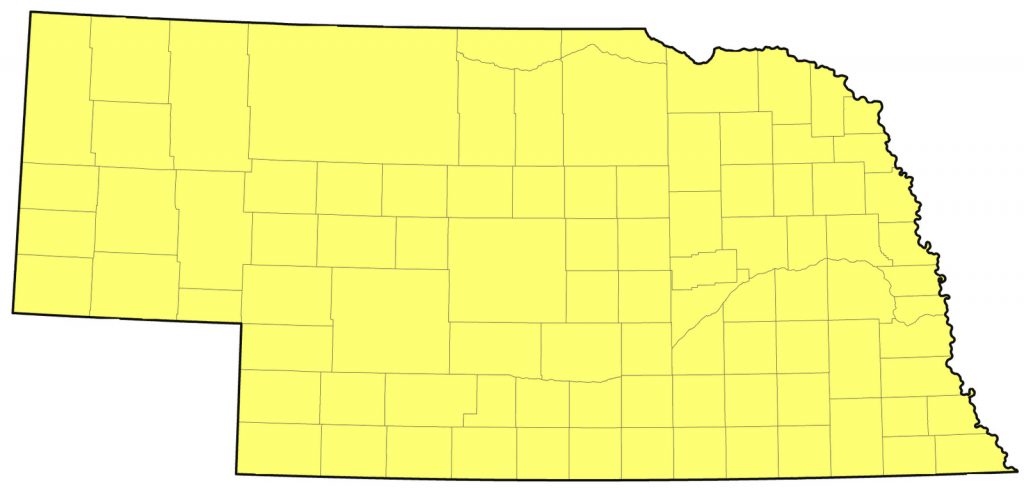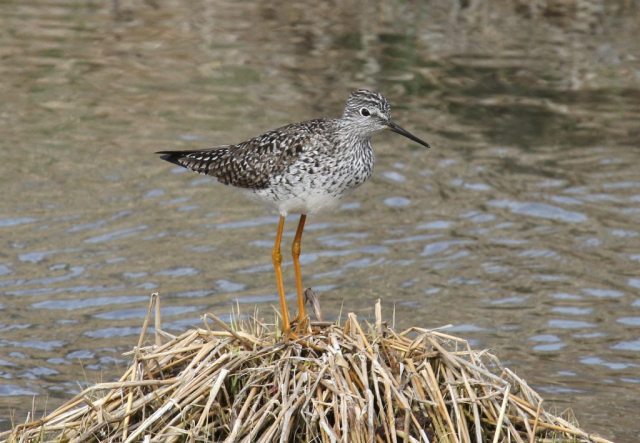Tringa flavipes
Status: Common regular spring and fall migrant statewide.

Documentation: Specimen: UNSM ZM12652, 12 Apr 1898 Lancaster Co.
Taxonomy: No subspecies are recognized (AviList 2025).
Spring: Mar 10, 11, 12 <<<>>> Jun 7, 8, 9
Earlier dates are 2-14 Mar 2012 Seward Co, 4 Mar 2024 Lancaster Co, and 7 Mar (Jorgensen 2012).
Later dates above are of sightings involving three or more birds, presumed migrants; for later dates, see Summer (below).
Arrival is generally at the end of Mar and the beginning of Apr. Numbers peak towards the end of Apr and decrease during May.
- High counts: 1812 in the eastern Rainwater Basin 27-29 Apr 2001, 812 there 24-26 Apr 1998, 500 there 27 Apr 2007, and 500 in Sarpy Co 1 May 2019.
Summer: There are 22 reports of 1-2 birds in the period 10-21 Jun which bridge the gap between spring and fall migration and may be one-year-old birds which did not complete migration. These are: 10 Jun 2025 Lake McConaughy, Keith Co, 11 Jun 2024 Garden Co, 12 Jun 2004 Sinninger WPA, York Co, 13 Jun 2004 Harlan County Reservoir, Harlan Co, 13 Jun 1992 Sheridan Co, 13 Jun 2019 Rock Co, 13 Jun 2020 Lincoln Co, 14 Jun 1961 Lincoln Co, 14 Jun 2008 Hultine WPA, Clay Co apparently injured (Jorgensen 2012), 16 Jun 2022 Keith Co, 17 Jun 2006 Phelps Co, 17 Jun 2018 Garden Co, 17 Jun 2019 Clay Co, 17 Jun 2021 Garden Co, 17 Jun 2025 Buffalo Co, 18 Jun 2025 Garden Co, 18 Jun 2012 Lincoln Co, 18 Jun 2018 Butler Co, 19 Jun 2021 Keith Co, 20 Jun 1990 Scotts Bluff Co, 20 Jun 2023 Kimball Co, and 21 Jun 1994 Sheridan Co.
There is no evidence this species ever bred in Nebraska despite some early reports (Mollhoff 2022).
Fall: Jun 22, 22, 22 <<<>>> Nov 6, 7, 8
Early dates above are of sightings involving three or more birds, presumably migrants. Earlier reports of 1-2 birds are discussed under Summer.
Later dates are 10 Nov 2023 Lancaster Co, 11 Nov 2016 Seward Co, and 7 Dec 2014 two Buffalo Co.
Adults arrive by the end of Jun and peak numbers are observed mid-Jul and early Aug. Juveniles arrive by late Jul and are the majority age group in Aug and Sep. Juveniles often flock in larger groups than do adults. Numbers dwindle in Oct and the species is only casually observed during the first half of Nov.
- High counts: 900 at Lake McConaughy, Keith Co 12 Sep 2022, 800 there 5 Sep 2021, 641 at Harvard WPA, Clay Co 20 Jul 2001, 614 at Lake McConaughy, Keith Co 7 Sep 2000, and 500 in the eastern Rainwater Basin 16 Jul 2000.
Images
Abbreviations
UNSM: University of Nebraska State Museum
WPA: Waterfowl Production Area (Federal)
Literature Cited
AviList Core Team, 2025. AviList: The Global Avian Checklist, v2025. https://doi.org/10.2173/avilist.v2025.
Jorgensen, J.G. 2012. Birds of the Rainwater Basin, Nebraska. Nebraska Game and Parks Commission, Lincoln, Nebraska, USA.
Mollhoff, W.J. 2022. Nest records of Nebraska birds. Nebraska Ornithologists’ Union Occasional Paper Number 9.
Recommended Citation
Silcock, W.R., and J.G. Jorgensen. 2025. Lesser Yellowlegs (Tringa flavipes). In Birds of Nebraska — Online. www.BirdsofNebraska.org
Birds of Nebraska – Online
Updated 22 Aug 2025

